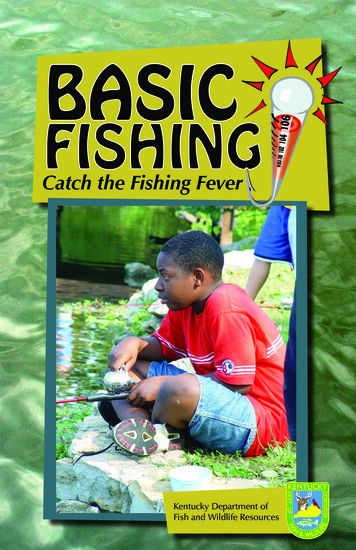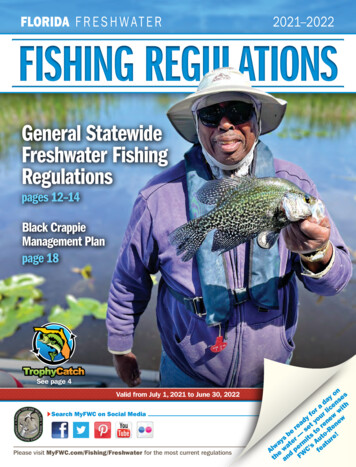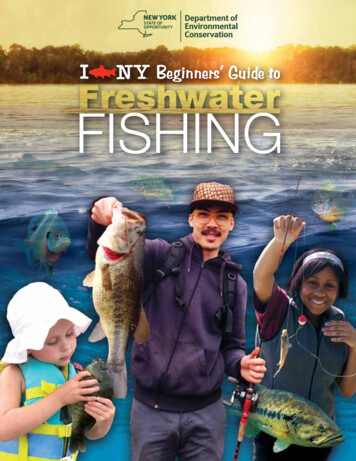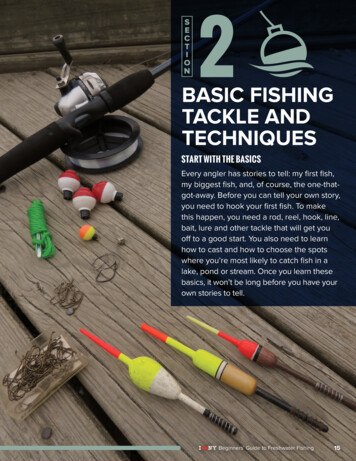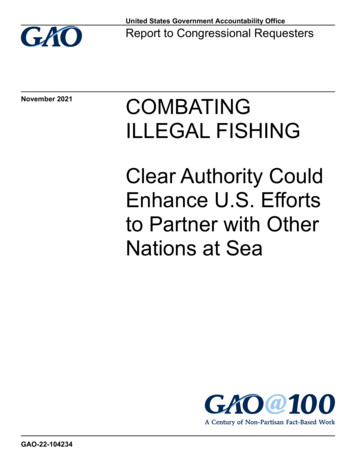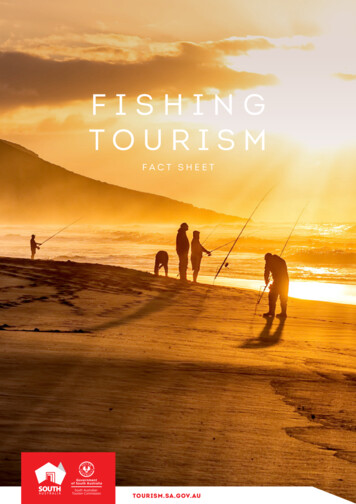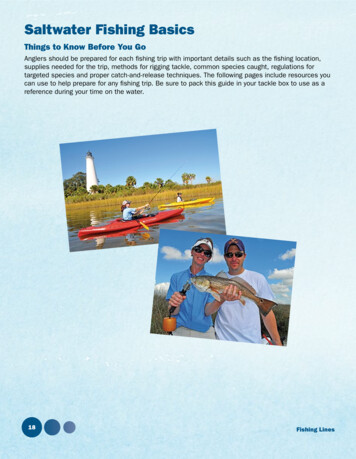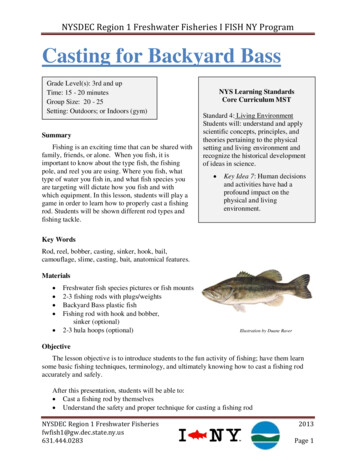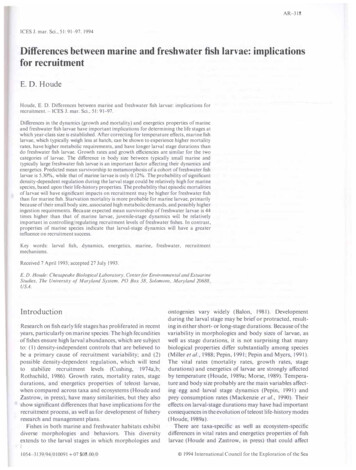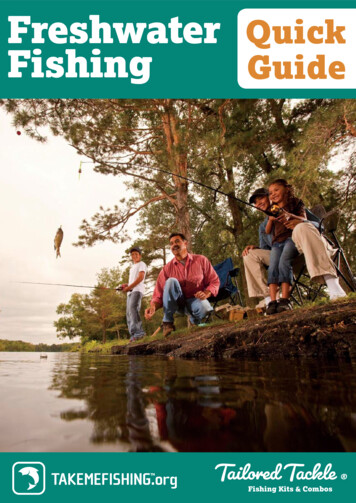
Transcription
Freshwater QuickFishingGuideFishing Kits & Combos
vLicense & RegistrationOne of the most important items any angler needs before they go fishing istheir fishing license. Each state has their own regulations and offers daily,short-term, or annual licenses. TakeMeFishing.org has a great tool to findout where to buy a fishing license, the types of fishing licenses available,age requirements, fishing regulations and online purchasing.1Click the button belowGET YOUR FISHING LICENSE2Select your stateReview the best licens3 ing options to fit yourfishing needsYour state’s profile has links to resources where you can review the statefishing regulations and browse different types of fishing licenses availablein your area. Many states allow you to purchase your license online andprint out a temporary license to go fishing the same day. Remember to review the age requirements as children, seniors and veterans often receivediscounts and unique opportunities for open fishing.1
Places to Boat & FishReady to get out on the water but not sure where to start?Click the VIEW MAP below to find Places to Fish and Boat across the United States.PLACES TO BOAT ANDFISH NEARBYType in your Townor City into theSearch BarVIEW MAPBody of Water to fish and boat onBest Place to Fish and Boat withfamily-friendly amenitiesBoat Ramp to launch your boatMarinas, moorings and suppliesBait Shop to buy fishing bait & luresFishing License VendorsCharter & Boat rentalsFishing Gear & equipment vendorsUse this list of Key Symbols on themap to find places to fish, bait shops,and hot fishing bites!Click on a blue Body of Water icon on afishing spot near you to: Review Logged CatchesView Photos of Fish CaughtFilter Fish Species in the AreaRead Fishing ForecastsGet Directions to that LocationFly Fishing shops.Fish Refuge or Hatchery FacilityMultiple Places of InterestLoggedCatchesFishSpeciesFishingForecasts2
Freshwater LureCrankbaitCast across shoreline transitions indepth and bottom, covering the fullwater column. Crank and pause on retrieve, letting the lure float up. Driveback down and repeat to mimic awounded baitfish.Pike SpoonSteadily retrieve alongside weedlines or directly above weed beds.Keep the pace consistent, you willfeel a big thud when a pike or basshit. Maintain tension to set thehook. Great for trolling as well.Feather SpinnerIdeal for trout lurking in streams andcreeks. Cast this spinner from bank tobank, covering a lot of distance. Steadily retrieve near the surface and try gliding it against a rocky bottom.Brass Rattle SpinnerGreat for ponds and small lakes,target aggressive trout and panfishwith this vibrant spinner. Work shallow shoals and shorelines, bumpingagainst rocks and flickering light tocall in fish.3
Quick SheetTexas RigThump against the bottom along weedlines and deeper transitions. Primarytargets include stumps, fallentimber, boulders, and brush piles. Weedless set up lets you getinto the thicket. Great year round!Drop Shot Rig GrubYour deep water go-to, use a dropshot rig and a white grub when bassand perch are 20 ft deep during thecolder months. Drift the sinker alongthe bottom, letting your bait ride high.Wacky RigUltimate finesse approach to largemouth,use this rig to target hard to reach bass indeep cover. Pitch the wacky rig under docksand small clearings, let the lure fall slowly with tails wiggling to coax finicky bass.Jig and Curl Tail GrubThe most versatile lure combo inthe world, a Jig Grub will catchanything! Jig it along the bottomof mid-lake structure, or swim italong the shoreline for your bestchance at a mixed bag of species.4
Live Bait RigCatfish are a great option to targetwhen fishing a river. One of the mostproductive ways to hook up with abig cat is with a simple bottom rig. Cut off a 2-3 ft piece of mono or fluorocarbonfishing line and set aside. With your main line, threadon a 1 oz egg sinker and a red bead, then tie on a barrelswivel. Now tie one end of the leader to your swivel, andthe other to a 5/0 circle hook. Cut up a 2-3” chunk ofminnow or sunfish and hook it right below the spine.Catfish Bottom RigTry to cast your bait into the deepest portion of the river, typically the middle. Reel in until your line is taut. Either hold or prop up your pole so thatthe line is consistently tight to your sinker. Monitor your rod tip for a bite.Trout typically feed in the middle of the water column within alake. Use a bottom rig to cast outdeep, with a floating bait to rise up to the feeding area. Cut off a 2-5 ft pieceof mono or fluorocarbon fishing line and set aside. With your main line, threadon a 1/4 oz egg sinker and a red bead, then tie on a barrel swivel. Now tieone end of the leader to your swivel, and the other to a #6 baitholder hook.Trout Bottom Rig5Ball up your power dough bait around the hook to the diameter of adime. Target depths of 10-20 ft so your bait floats reasonably close tothe middle. Keep your line taut, holding or propping up the pole. After a tap, let the Trout take it for 5-10 seconds, then set the hook.
Quick SheetLive Bait Slip BobberSlip Bobbers arethe most versatile method forfishing with live bait as they allow you to target any depth whilekeeping your minnow lively and your presence subtle. Set yourdepth by pushing the slip-tie up on your line until the sinker hashit the bottom. Push your slip-tie back down 2-3 ft so your baitsits just above the bottom. Let the wind take your bobber about20-30 yds away to cover more water, but no farther as you arelikely past your set depth. When you have a hit, let the fish takethe bobber all the way down before setting the hook. Check yourbait every 10-15 minutes, changing at least every 30 minutes.See step by step rigging instructions in the following section.Live Bait JigsTarget fish holding deeper, with live bait jigs. Hook on aminnow to the 1/4 oz live bait jig as pictured. Fish in 1030 ft of water, bouncing the bait along the bottom . Letit hit bottom, lift back up, drop and pause. This motion isa classic jigging pattern. Ideal for rocky, muddy, or sandybottoms without snaggy weeds, you can pitch your jig bycasting and retrieving. The most popular method is to driftyour jig along the bottom, keeping it a few inches off theground and jigging every 10 seconds.Freshwater lures and rigs in the Quick Guide arefrom the Tailored Tackle Freshwater Fishing Kit.6
Set Up a Fishing PoleSpooling Line1Remember to open the bail2Run line through each guide startingfrom the rod tip down to the reel3Tie an arbor knotaround the spool4Place spool in water toreduce memory in line5Reel your line slowly, add pressure bypinching line with thumb index finger6Don’t fill it all up!Leave about 1/8” gapSpool your reel with monofilament or braided line up to 3/4 the capacity. Tospool your reel, run the line through your rod guides and tie an arbor knot toyour spool while the bail is open. Place the spool holding your new line in a potof water. Apply tension with your thumb and index finger while you reel the lineon, leaving a 1/8” space between the line and the base of the spool.7How to TietheArbor Knot12345
Rig Up a Slip Bobber1. Thread 2-3 ft of line through the slip tie tube and slide thetie off the tube, removing the tube off of your line.2. Pull on both tag ends until the slip tie is lightly snug onyour line.3. Thread on a neon bead. This keeps your line from chaffingagainst the slip bobber. Then thread on your slip float, neonside first.4. Push your bobber against the bead slip tie. Tighten thetie snug enough to stop the bobber but still loose enough tomove up and down your line with finger pinched pressure.Clip the tag ends down to 1/2”.5. Tie on your hook with a clinch knot.How to Tie a Clinch Knot6. Pinch on a 3/0 split shot sinker about 1-2 ft above thehook so your slip float stands straight in the water.7. Push the slip tie up or down to set depth.8. We recommend worms, minnows or leeches as bait.8
Bait Your HookGet started catching some easy panfish from the shore. Grab a 12 count cupof nightcrawlers from a local bait shop or dig some up in your backyard. Pincha nightcrawler into a 1/4 length piece. Thread the piece’s tail through the barband up the hook shaft. Then, pierce the worms opposite end into the barb,covering the hook tip. 4-5 kernels of corn or small slices of hot dog can work asreplacements.Beginner BaitNightcrawlerCornHot Dog SlicesMinnows and leeches are typically used to target larger and more advancedspecies like walleye and bass. You can rig these up with your slip float, bouncethem with a jig, or present them on a live bait rig. You can even step up yourpanfish game with micro-sized wax worms. Review the Live Bait Rig QuickSheet to rig up and effectively use these baits when you’re ready to advance.Advanced BaitLeech9ShinerMinnowCrappieMinnowWax Worms
Cast Your Fishing PoleStarting Position: Your fishing comboshould be in front of you with the reeland rod guides facing down.1. Hold the reel’s shaft in-between yourmiddle and index finger. Pull the lineagainst the rod handle with your indexfinger and open the bail (metal half circle) with your opposite hand.2. Look behind you to make sure you are clear of other anglers as well as objects your hook could catch. Slowly bring the rod 90 to your side. Keep pressing your finger against your line and against your rod.3. Sway your rod back to its original position in front of you, releasing the linefrom your index finger at the apex of your rod fully extending forward. Closeyour bail to re-engage your fishing reel and begin your retrieving presentation.4. For greater casting distance, repeat these steps over your shoulder vs. at yourside. An over the shoulder cast will give you more velocity, however accidentsare more likely to occur so graduate to this style after you master the side cast.10
Catching FishLet your bait sit for 5-10 minutes. When the bobberbegins to move abruptly you have a bite! If the bobbergoes under, bobs rapidly, or is consistently moving to theside for over 5 seconds, the fish has taken the bait. Reel in some line by rotatingthe reel handle counter clock-wise. Once the line is taut, set the hook by swiftlylifting your rod tip a few inches. Once the fish is locked in, gradually reel thefish in by balancing the tension of the fight with the pace of your retrieve toavoid losing the fish.The Bite!The Tailored TackleMultispecies Combo(Left) is a great optionto fish multiple freshwater species withone rod & reel.Maintain pressure and never let your line go slack.Keep your rod tip up so you maintain leverage overthe fish. Adjust your drag so that line pulls outgently when tough tension is applied. Drag will give the fish room to wear itselfdown without allowing slack to form. Retrieve at a steady pace, slowing downif the fish runs, and speeding up when the fish gives. When preparing to land,never let your lure or rig get close to your rod tip.The Fight!11
Releasing FishLift your freshly caught fish fully out of thewater, be careful not to let it fall to the ground.Cup the belly of the fish with the palm of yourhand so the spine remains exposed. Remove the hook by gripping your pliersright below the eyelet of the hook. Push the hook down into the fish’s mouth,rotate the hook away from the point, and remove. Sometimes you will need totwist, dig, and rotate the hook for removal. You can also remove the hook byapplying pressure on the eyelet with your opposite thumb and index finger.Push the hook towards the fish extracting the barb, then remove.Remove HookRemove by HandRemove by PliersReleasing FishRelease your catch by submerging the fishwith your hand cupping the belly. Let thefish paddle off on its own as you open your hand. If the fish is not kicking off onits own, hold it upright in the water cupped by the belly with one hand. Withyour opposite hand, wag the tail back and forth. Repeat this process 3-4 timesover 5 minutes to resuscitate the fish. If the fish does not revive, please harvestit according to state regulations. Otherwise, contact the local DNR.12
Where to FishTarget panfish such as bluegill, sunfish, perch and crappie in 3-10 ft depths.1.) Right Next to the Dock: These species love to be close to cover like a dockbecause it gives them shelter from predators and hosts abundant food sources.If you have access to a dock, set your line up near the posts of the dock as manypanfish tend to congregate there.2.) Vegetation: Panfish also love hiding in weed lines, if you do not have accessto a dock, nearby weeds are a good spot to target. Panfish will be located in andaround the weeds, try to get your bait close to the outer edges of the weeds.3.) Transitions in Structure: If the dock or shoreline you are fishing has a changein depth of a few feet, this transitional location will often hold panfish. If the bottom contents change, like soft silt - rocks, panfish will hold along that transition.Advanced Fish FindingStructure: Fish hold to it, particularly where transitions in structure occur.Changes in depth or bottom consistency are the general markers of structuralchange. Common structural features that support these changes are creek channels, points, humps, holes, and drop offs.Cover: Fish use cover to find shade and ambush prey. Cover is made up of natural and man made features that provide ideal characteristics for fish to feed.Examples of cover are docks, weed beds, boulders, logs, sunken trees, lily pads.Structure Cover: Your goal is to position yourself on structure (where fish areholding) and target areas that supply cover (where fish are primed for striking).An example of this would be at the end of a dock that has a steep transition indepth (drop-off). Fish will often position themselves along the changes of a dropoff, and the smaller area where the dock provides shade is an ideal position13 for a fish to feed along that drop-off while they benefit from shade.
Lake Map ExampleCreek channels are an ideal starting place because their s-turns andsloping framework cover long expansions of water that serve as underwater highways for fish and their bait. Seconded by points and drop offs, these structures relate to the surrounding topography and corral fish along the greater outlay of the water body. Humps, holes,and sunken islands serve as an oasis drawing in fish from the greater expanse. Usea lake map or an app to get a general sense of your lake’s layout. If fishing from aboat, electronic sonar will best assist you in identifying deeper water structure.Mapping StructureDocks and overhanging features are atypical go-to as they do not require electronics and are accessible by boatersand shore anglers. Boulders and brush piles require the use of electronics to target effectively and are generally less accessible from shore. Lily pads and thickvegetation shelter fish in shallower waters that are accessible by boaters andshore anglers. In summary, target areas that provide shade.14Identifying Cover
Largemouth BassBass are popular inhabitants of lakes, ponds, rivers &streams across the country. Bass are most active fromMay to August, feeding heavily at dawn and dusk, butcan be caught throughout the day. Generally fished in 5-15 ft of water, bass holdto shady areas. Target overhanging cover like docks, branches and lily pads orsubmerged cover like weed beds, brush piles, and boulders. Ideally, these arenear changes in depth or bottom.LocationLuresCrankbaitTacticWacky WormFinesse WormBass are reactive, so fish aggressively for a reaction. Castartificial lures that provide an erratic presentation. Fish alot of water. Target a new spot on every cast, covering a new area every 30minutes. Start deeper, but fish various depths at different levels of the watercolumn. Try to retrieve your lure through changes in structure or cover. The keytakeaway is to stay mobile and experiment with presentations.TechniqueCrankbait: Crank down andpause on the retrieve to mimic awounded baitfish. Set the hookright when you get a thump.Soft Plastics: Swoop yourworm along the bottom as youretrieve, lifting and dropping it3-4 ft. Give it a 5 second pauseon the bottom (most bites), setthe hook on a tap-tap.15
PanfishBluegill - SunfishBream - CrappiePanfish can generally be found anywhere and are thebest species for learning how to fish or taking kids fishing. They hold to areas that provide protective coverfrom predators and the hot sun. Almost any dock in freshwater will hold panfishunderneath it. Simply drop a worm under a slip bobber rig off a local dock or marina and you will catch fish. When fishing from shore, target the edges of a weedline or a bed of weeds in roughly 3-10 ft of waterLocationLuresBobber & WormGrub JigRattle SpinnerPanfish are aggressive sight feeders so get your bait right infront of them. For massive quantities of panfish, simply fisha bobber and worm halfway down the water column nearshady cover. If you are trying to hone in on trophy panfish, use an artificial grubor lure to sort through the smaller fish. Bigger panfish can be found stratified indeeper water (20-30 ft) like the basin of a lake.TacticLive Bait: Fish fast, changing your bait often andgetting it back down. Panfish have small mouths solet them hit it 2-3 times before setting your hook.When the bobber completely submerges, set your hook. If the bobber is bobbing or moving rapidly for more than 3 seconds, also set the hook.TechniqueLures: In deeper water, use thegrub jig. Jig the lure by lifting andfalling roughly 2-3 ft off the bottom.Remember to pause after the fall tolet the fish hit. For bigger panfish inthe shallows, cast your rattle spinneralongside weed lines, retrieving ata constant pace so the lure glidesthrough the middle of the watercolumn.16
Walleye & PerchLocationWalleye & perch habit deeper, cool water. 15-30 ftdepths in general, 7-15 ft in colder months and 25-40 ftin deep summer. They feed 1-3 ft off the bottom, and hold to structure. Substantialchanges in depth and bottom consistency are key. Focus on near shore points anddrop offs in Spring, mid-lake structure like humps and holes in Summer, and mudflats in Fall. Key in on the bottom transitions like weeds to sand or rocks to mud.LuresBobber & MinnowJig & LeechGrub JigPresent your bait in the strike zone, 6 in - 1 ft off bottom atany depth. Use a slip bobber with lively bait when the bite isslow, jig live bait when the bite is moderate, and jig plasticslike a grub when the bite is aggressive to key in on bigger fish. Walleye & perchfeed on the same forage, so minnows and leeches work for both. Drift all presentations along the bottom, letting the wind propel you, or use a trolling motor atlow speeds.TacticTechniqueSlip Bobber: Let the windcarry your rig 20-30 yds eachdrift. Wait until your bobbersubmerges 2-3 ft, reel in anyslack and set the hook.17Slip BobberWalleyeJigging: Keep your jig 1 ft offbottom. Lift up 1-2 ft, dropdown, then pause. Repeatevery 15 seconds. Most hitscome at the pause. After youfeel a “tap-tap” wait 3 seconds and set the hook.
TroutRainbow - BrownBrook - CutthroatTrout are found in rivers, streams, lakes and stockedponds across the country. While species and regions vary,these general tips work for trout everywhere. In riversand streams, trout love deeper pockets of water. Look for darker pools, near themiddle that sport slower moving water. In lakes & ponds, trout typically navigateadjacent to shoreline. They prefer cooler water, ideally 20-40 ft depths. However,trout often hold to the top half of the water column so fish halfway down.LocationLuresBottom RigFeather SpinnerRattle SpinnerStay quiet and stealthy, in clear water. Trout can see you fromabout 15 yds away and scatter from sudden noises. Lures arepreferred for rivers/streams. Cast upstream so your lure retrieves naturally with the current. Defer to a bottom rig floating bait when fishinglakes/ponds from shore. If fishing from a boat, troll lures instead. Troll your lure100 yds back at 1.3-1.7 MPH, add a series of split shots to get deeper.TacticRiver/Stream:Cast upstream,from one bankto the other in a diagonal line to cover allchanges in structure. Vary pace so thatyou fish all levels of the water column, prioritize deep pools. Stay mobile & quiet.TechniqueLake/Pond: Cast the bottom rig as deepas you can ( 30 yds) and let it fall to bottom. Reel in until line is taut betweenyour tip and the weight. Hold or prop upyour rod, monitoring the tip for a bite. After you see a “tap-tap”, wait 5-10 secondsfor a second “tap-tap.” After the secondtap, or you see a hard tug, set the hook.Cutthroat Trout Bottom Rig18
Northern PikeLocationNorthern Pike and Chain Pickerel are found in lakesand rivers across the US, but predominately in thenorthern states. These are aggressive predators that react to flashy and loudpresentations. Most often lurking in the weed lines near shore, pike habit 5-15 ftdepths wherever panfish and baitfish are schooling. They aggressively sight feedand are most active during morning and evening hours. However, you can catchpike anywhere at any time.LuresPike SpoonCrankbaitBobber andL. MinnowPike roam individually, or in packs of 2-3. To find them, use luresthat reflect light and make a lot of noise. Cast a pike spoonalong weed lines or above weed beds to pull them out of cover.When fishing a rocky or deeper body of water, cast a crankbait to get down further.Keep moving & cover a lot of water. If mobility is an issue, let the Pike come to youby fishing a larger shiner minnow under a float.TacticTechniqueLures: Use a wire leader. Cast andretrieve at a steady pace, halfwayup to the top of the water column.Sternly set the hook right when youfeel a thump, the trebles and speedwill do most of the hook setting foryou.19Live Float: Set your depth 2-4 ftoff the bottom and bait your hookthrough the back of the minnowjust before the tail. Cast right alongthe edge of the weeds. Changeyour bait every 15 min. Wait for yourfloat to submerge for 5-10 seconds,then set the hook.
CatfishLocationCatfish are the quintessential river monsters, also foundin reservoirs and stocked lakes. Cats hug close to thebottom and forage with their whiskers. Target depths range dramatically (10-40ft), focus on the deepest section of water 50 ft. The middle of a river where theoriginal channel slopes on the bottom will hold cats. Deeper pockets shelteredfrom the current like eddys require less energy from cats at the same depth. Catsmost actively feed at night from evening to morning.Bottom RigCut BaitNightcrawlersDough BaitGet your smelly bait on the bottom, holding against the current and let it sit. All the above baits work, however Cut Baitis best for targeting trophy sizes. Start fishing in the afternoon to find a safe and productive location for the evening/night bite. Find a deeper spot where current is light enough for your sinker to hold. Check your bait every20 minutes, otherwise the current and small fish will poke away at your offering.TacticTechniqueBottom Rigging: Cast out to the deeper section ofthe river. Once the weight hits bottom, reel in anyslack. Keep your line taut and prop up your rod, monitoring your tip for a bite.Cats suck in and spit outtheir meals a few timesbefore committing. If yousee a tap, leave it. Waituntil you see repetitivetaps or a big pull. Thecat’s got it and is eithershaking its head or aboutto run. Set the hook.Keep leverage with yourrod tip up to avoid snagging on river debris and20rocks.
How To Clean a Walleye1Lay the fish on its side so that thespines are facing you. (1)Locate the side fin and slice downfrom the side fin back towards thespine, deep enough to pass themeat. (2)2Turn the knife horizontal andcut front to back, just above thespines. (3)About halfway back, poke theknife carefully through the fish andcontinue cutting towards the tail.(4)3Apply pressure, slicing back forthagainst the spine until you reachthe tail. (5)4215
6Open up and carefully cut aroundthe ribcage from the top to the bottom, in an arc towards the belly. (6)78Cut in a strait line along the bellyuntil you reach the tail. (7)Do not slice off the side of the fishyet. Flip it over, still attached to thetail. (8)Press the tail down with your fingers, slice down at the edge of thetail until you reach the skin. (9)9Lay your knife flatly angled towardsthe skin, and carefully shave againstthe skin back and forth. After thefillet is removed, repeat on the opposite side. (10/11)111022
How To Clean a TroutHow to Gut a Trout1Cut the gill away from the jaw. (1)Pierce through the belly near the anus, cutup towards the head of the trout in a straightline. Grab the base of the gills and pull down,removing all the organs. Rub your thumbagainst the spine to remove blood. (2)(Optional) To cook Trout with the skin on,remove the scales by grinding the back ofthe blade against the scales until the skin becomes smooth and semi transparent.2OptionalTo harvest a fillet, proceed to the nextsection. Otherwise, you can cook theTrout whole, eating off the bone.How to Fillet a Trout3Start with the trout’s head facingyour dominant hand. Break theneck by snapping it backwards. (3)To remove the bones from the fillet,slip the blade right beneath the ribbones, working the knife up alongthe rib cage to separate. (4)Flesh out any left over bones withthe edge of your knife, working upwards from the spine to the belly.Flip over and repeat. (5)2345
6Pierce blade through the back, rightabove the neck. Cut from head to tail,as close to the spine as possible. Flipover & repeat. (6)7Remove the head by cutting acrossone fin to the other, severing thespine. Remove dorsal fins. (7)Cut at the base of the tail to removethe spine, leaving the tail on. (8)8For a skinless fillet move onto thenext section. Otherwise, sever eachfillet from the tail and wash beforeyou cook.How to Skin a TroutPress 2 fingers firmly down at the tail.Slant your knife to a 45 angle nearthe base of the tail. Slowly draw yourknife back and forth until you are underneath the meat, pressing againstthe skin. (9)910Lay your knife flat. Work your knifeback and forth against the grain ofthe skin, separating the fillet from theskin. Repeat on opposite side. (10)11Trim any fins or fat that were missedfrom steps 1-10. Run under cool water, feeling for any missed bones. Dryoff and prep your meal! (11)24
cle) with your opposite hand. 2. Look behind you to make sure you are clear of other anglers as well as ob-jects your hook could catch. Slowly bring the rod 90 to your side. Keep press-ing your finger against your line and against your rod. 3. Sway your rod back to its original position in front of you, releasing the line
